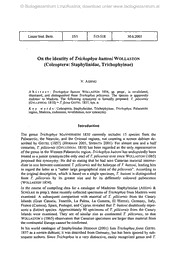
On the identity of Trichophya huttoni WOLLASTON (Coleoptera: Staphylinidae, Trichophyinae) PDF
Preview On the identity of Trichophya huttoni WOLLASTON (Coleoptera: Staphylinidae, Trichophyinae)
© Biologiezentrum Linz/Austria; download unter www.biologiezentrum.at Linzer biol. Beitr. 35/1 515-518 30.6.2003 On the identity of Trichophya huttoni WOLLASTON (Coleoptera: Staphylinidae, Trichophyinae) V. ASSING Abstract: Trichophya huttoni WOLLASTON 1854, sp. propr., is revalidated, illustrated, and distinguished from Trichophya pilicornis. The species is apparently endemic to Madeira. The following synonymy is formally proposed: T. pilicornis (GYLLENHAL 1810) = T.foina GlSTEL 1857, syn. n. Key words: Coleoptera, Staphylinidae, Trichophyinae, Trichophya. Palaearctic region, Madeira, endemism, revalidation, new synonymy. Introduction The genus Trichophya MANNERHEIM 1830 currently includes 15 species from the Palaearctic, the Nearctic, and the Oriental regions, not counting a nomen dubium de- scribed by GISTEL (1857) (HERMAN 2001, SHIBATA 2001). For almost one and a half centuries, T. pilicornis (GYLLENHAL 1810) has been regarded as the only representative of the genus in the Western Palaearctic region. Trichophya huttoni has undisputedly been treated as a junior synonym (the only one) of T. pilicornis ever since WOLLASTON (1865) proposed this synonymy. He did so stating that he had seen Canarian material interme- diate in size between continental T. pilicornis and the holotype of T. huttoni, leading him to regard the latter as a "rather large geographical state of the pilicornis". According to the original description, which is based on a single specimen, T. huttoni is distinguished from T. pilicornis by its greater size and by its differently coloured pubescence (WOLLASTON 1854). In the course of compiling data for a catalogue of Madeiran Staphylinidae (ASSING & SCHÜLKE in prep.), three recently collected specimens of Trichophya from Madeira were examined. A subsequent comparison with material of T. pilicornis from the Canary Islands (Gran Canaria, Tenerife, La Palma, La Gomera, El Hierro), Germany, Italy, France (Corsica), Spain, Portugal, and Cyprus revealed that T. huttoni doubtlessly repre- sents a distinct species. Approximately 90 specimens of T. pilicornis from the Canary Islands were examined. They are of similar size as continental T. pilicornis, so that WOLLASTON's (1865) observation that Canarian specimens are larger than material from the continental Europe cannot be confirmed. In his world catalogue of Staphylinidae HERMAN (2001) lists Trichophya foina GlSTEL 1857 as a nomen dubium; it was described from Germany, but has been ignored by sub- sequent authors. Since Trichophya is a very distinctive, easily recognized genus and T. © Biologiezentrum Linz/Austria; download unter www.biologiezentrum.at 516 pilicornis is the only species present in continental Europe, there is little doubt that T. foina is conspecific with T. pilicornis, so that the following synonymy is here formally proposed: Trichophya pilicornis (GYLLENHAL 1810) = T. foina GlSTEL 1857, syn. ri. Trichophya huttoni WOLLASTON 1854, sp. propr. (Figs. 1-4) Trichophya huttoni WOLLASTON 1854: 572. Material examined: 3 exs., Madeira, S Seixal, 400-500m, 16.-30.I.1999, leg. Lebenbauer (author's collection). Remarks: Trichophya huttoni (Fig. 1) is readily separated from T. pilicornis by greater body size (3.5-4.0 mm in normal preparation; width at elytra: ca. 1.0 mm; width of pronotum: ca. 0.8 mm; T. pilicornis: 3.0-3.5 mm, ca. 0.8 mm, and 0.7 mm, respec- tively). In addition, it is separated by more pronounced microsculpture and consequently less shine on the whole forebody, a more transverse pronotum with less abrupt impres- sions in the postero-lateral areas, a more strongly microsculptured abdomen, a truncate posterior margin of the male tergite VIII (Fig. 2) (in T. pilicornis weakly to moderately convex), and a completely different morphology of the aedeagus; the ventral process of the median lobe is longer, more slender, and more strongly curved (lateral view), the parameres are longer and more slender, and the sclerotized internal structures are differ- ently shaped (Figs. 3-4). For illustrations of the aedeagus of T. pilicornis see Figs. 5-6. Distribution: Trichophya huttoni is apparently endemic to Madeira and of utmost rarity. The specimens listed above represent the first record since the discovery of the holotype. Acknowledgements I am grateful to Thomas Lebenbauer, Pitten, and Rudi Schuh, Wiener Neustadt, for the generous gift of the material of Trichophya huttoni. Zusammenfassung Trichophya huttoni WOLLASTON 1854, sp. propr., wird revalidisiert und von Trichophya pilicornis unterschieden; Differentialmerkmale werden abgebildet. Die Art ist offenbar auf Madeira ende- misch. Folgende Synonymisierung wird vorgenommen: T. pilicornis (GYLLENHAL 1810) = T. foina GlSTEL 1857, syn. n. References GlSTEL J. (1857): Achthundert und zwanzig neue oder unbeschriebene wirbellose Thiere. — Straubing, Verlag der Schorner'schen Buchhandlung: 94 pp. HERMAN L.H. (2001): Catalog of the Staphylinidae (Insecta: Coleoptera). 1758 to the end of the second millennium. — Bull. Am. Mus. Nat. Hist. 265: 1-4218. SHIBATA Y. (2001): A new species of the genus Trichophya (Coleoptera, Staphylinidae) from Taiwan. — Elytra 29: 352-357. © Biologiezentrum Linz/Austria; download unter www.biologiezentrum.at 517 WOLLASTON T.V. (1854): Insecta Maderensia; being an account of the insects of the islands of the Madeiran group. — London, J. van Voorst: 634 pp. WOLLASTON T.V. (1865): Coleoptera Atlantidum, being an enumeration of the coleopterous insects of the Madeiras, Salvages, and Canaries. — London, J. van Voorst: xlvii + 526 pp. + appendix (140 pp.). Author's address: Dr. Volker ASSING Gabelsbergerstr. 2 D-30163 Hannover, Germany e-mail: [email protected] © Biologiezentrum Linz/Austria; download unter www.biologiezentrum.at 518 Figs. 1-6: Trichophya huttoni WOLLASTON (1-4) and T. pilicornis (GYLLENHAL) (5-6): 1 - fore- body; 1-6 tergite VIII; 3-6 - aedeagus in lateral and in ventral view. Scales: 1: 1.0 mm; 2-6: 0.2 mm.
